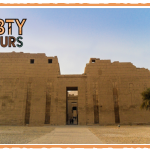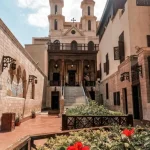Name of Monument:
Citadel of Salah al-Din al-Ayyubi
Also known as:
Citadel of the Mountain (Qala’a al-Jabal)
Location:
The Citadel of Salah al-Din al-Ayyubi, located in the east of old city, on one of the elevated heights linked to the Muqattam Hills; it is a commanding site, with a view over the entire city, Cairo, Egypt
Date of Monument:
Hegira 579 / AD 1184
Period / Dynasty:
Ayyubid
Patron(s):
Al-Malik al-Nasir Salah al-Din al-Ayyubi (also known as Saladin, r. AH 564–89 / AD 1169–93).
Description:
The Citadel of Salah al-Din al-Ayyubi, known also as Citadel of the Mountain (Qala’a al-Jabal), is one of the most important landmarks of Cairo and amongst the most imposing military citadels to be built in the Middle Ages. Having assumed power in Egypt Salah al-Din al-Ayyubi (Saladin) noted that despite its grandeur and vastness Cairo did not have a citadel to protect her like other great cities in the Levant such as Damascus and Aleppo. He therefore began to construct the citadel, ordering construction of its walls, semi-circular towers and its two gates: Bab al-Qarafa and Bab al-Mudarraj. Saladin’s son, Al-Malik al-‘Adil (r. AH 596–615 / AD 1200–18) completed the building of the citadel and surrounded some of the towers with outer encasing towers, in order to increase their impregnability, these included three towers: Burg al-Imam, Burg al-Ramla and Burg al-Haddad. He also added two square towers: Burg al-Turfa and Burg al-Karkialan. These works were completed in AH 604 / AD 1207.
In its present form the citadel is a great city, the borders of which are marked by massive walls and towers. It is divided into two parts: the northeastern section and the southwestern section. The northeastern section represents the citadel’s military fortifications. It is confined inside an irregular rectangular area whose length from east to west measures 560 m and whose width from north to south is 317 m. The walls of this section are in proportion to each other due to the fact that they were built in, and are associated with, a single period.
The southern side of the wall of the northeastern military section begins with Burg al-Muqattam, from the western side. This is a circular tower, dating back to the Ottoman period. Next is the Burg al-Suffa a quasi-rectangular tower, adjacent to which is the square tower, Burg al-Karkialan. This tower is followed by another, square tower, Burg al-Turfa. The southern side ends in the east with a circular tower, Burg al-Mubalat. The eastern side consists of four circular towers: Burg al-Muqawsar, Burg al-Imam, Burg al-Ramla and Burg al-Haddad. The northern side is composed of two great quasi-circular towers: one of which is Burg al-Sahraa, and the other does not have a name. On the western side of this section there is a gate, Bab al-Mudarraj, and the shared wall between the northern military section and the southern residential section.
The walls of the citadel are 3 m thick and their height from within the citadel averages 10 m. The heights of the towers increase at times to over 20 m. A passageway leading to narrow, square rooms passes through the walls, the width of which measures about 90 cm. The towers contain rectangular chambers. There are two side-rooms in each tower in the form of two arms; the rooms have slits for shooting arrows. This section of the walls was built in a relatively short period of time that did not exceed seven years (AH 572–9 / AD 1176–83).
The southwestern section of the citadel still preserves the features of a royal city resplendent with palaces and mosques. A successive number of rulers participated in building it, from the period of Saladin to the period of the Ottoman Pasha Muhammad Ali (r. AH 1220–64 / AD 1805–48). This section occupies an irregular surface area, which is slightly smaller than the area of the military, northeastern section. The greatest distance in it from north to south reaches 510 m, and from east to west 270 m. Al-Malik al-Kamil bin al-‘Adil (r. AH 615–35 / AD 1218–37) is considered to be the first to transfer the seat of government and administration to the citadel in AH 604 / AD 1208 during his occupation of the position of deputy (to his father) of the sultanate in Egypt. The Citadel of Salah al-Din al-Ayyubi continued to be the seat of government for close to seven centuries until Khedive Isma’il made the ‘Abidin palace located outside the citadel the official seat of his rule in the year AH 1276 / AD 1874.
The style used in the construction of the citadel walls and towers follows those used in the building of the walls of Fatimid Cairo in AH 480 / AD 1087, seen in features such as the attention paid to the alignment of stone, as well as the use of interlocking voussoirs seen in Bab al-Mudarraj, and the projecting balconies of Burg al-Haddad. However, new architectural elements also appear in the Citadel, such as the circular towers. There is a similarity between the architectural components of Citadel of Salah al-Din al-Ayyubi and those which are specific to two citadels in Jordan: the Citadel ‘Ajlun (built AH 580 / AD 1184) and Citadel al-Kark which, incidentally, was restored by al-Malik al-‘Adil.View Short Description
How Monument was dated:
This building was dated based on two epigraphic inscriptions bearing the name of the builder and the date of construction. The first inscription is on Bab al-Qarafa and bears the date, 576 / 1180; the second is on Bab al-Mudarraj and bears the date, 579 / 1184. Historical sources such as that by Maqrizi, al-Khitat, and al-Nujum al-Zahira by Taghri Bardi, confirm the validity of these dates. Further information with regard to dating can be found in Combe et al, detailed in the bibliography.
Source: [https://islamicart.museumwnf.org/database_item.php?id=monuments;ISL;eg;Mon01;8;en&cp]



